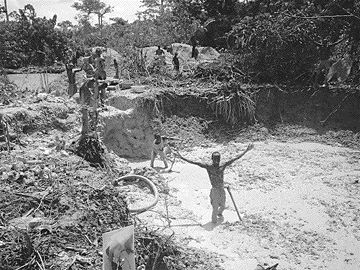Commentary
— The following is an edited version of information bulletin published by Vancouver-based PMI Gold.
In late May, our company published a release discussing a drilling program on the Agyaka Manso concession, the southernmost of eight concessions which comprise the Ashanti II gold project in Ghana. Our company is testing under galamsey workings in the Appiahkrom showing, where several hundred galamsey, or local artisinal gold miners, have been working a series of narrow quartz reefs carrying consistent gold mineralization.
I was surprised to find during my calls to PMI shareholders that an overwhelming number of the queries had to do with the “several hundred galamsey” working on our property.
In some cases, shareholders were downright alarmed and thought that these workers were “stealing our gold.” At the end of June, I was still fielding calls about galamsey. I think it’s time to set the record straight.
For those who have little desire to read on, suffice it to say that to have hundreds of galamsey workers on your property can be a good thing — because if there were no gold, no one would be there.
Here is a short introduction to the galamsey of Ghana, West Africa. Galamsey — meaning “to gather and sell” — are generally independent of mining companies that officially own the mineral rights.
As they are not licensed to use explosives, and cannot afford heavy equipment, galamsey are limited to “soft” gravel deposits and near-surface rocks. They are usually forced to stop when they hit the water table, owing to a lack of pumps.
The “deep galamsey workers,” require an average ore grade of 10 grams gold per tonne to pay for their efforts — anything less and they go broke. On the other hand, the alluvial (surface gravel workings) workings can pay at only 2 grams gold, as they are washing gravel rather than breaking rock.
Who are the galamsey? They are mostly farmers who supplement their meagre incomes in the dry season by mining gold.
In many cases throughout Africa, it is the galamsey who are the first to discover extensive gold deposits, well ahead of mining companies. Most of the big gold mines have been previously “worked” by them — including AngloGold Ashanti and Iamgold’s Sadiola mine in Mali, and Anglogold Ashanti’s Obuasi and Newmont Mining’s Yamfo-Sefwi, both of which are in Ghana.
Galamsey have been active in Africa for thousands of years and are part of the local culture. Generally, once an ore deposit is outlined by modern exploration and a production decision is made, the galamsey have long since run out of economic ore and left. The amount of gold mined by them is typically a small fraction of the mine’s reserves.
At the very least, to have a few hundred galamsey on your property certainly indicates the presence of gold, and therefore a good place to look closely for “new” discoveries.


Be the first to comment on "‘To gather and sell’"